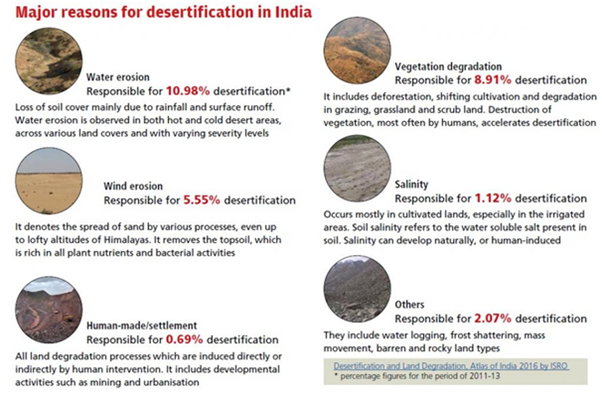

|
Overview
|
Context
According to the Drought in Numbers, 2022 report released at the 15th Conference of Parties (CoP15) to the United Nations Convention to Combat Desertification (UNCCD), the frequency and duration of drought is increasing at an alarming rate across the world since the onset of the 21st century.
Background
- According to Desertification and Land Degradation Atlas of India, released by the Space Applications Centre of the Indian Space Research Organisation, some 97.85 million hectares (mha) — nearly 30 per cent of India’s total geographical area (TGA) — underwent land degradation during 2018-19.
- In 2003-05, 94.53 mha (28.76% of the TGA) underwent land degradation. This number increased to 96.40 mha (29.32% of the TGA) in 2011-13.
- Some 83.69 mha underwent desertification in 2018-19.
- The level of desertification increased in 28 of 31 states and Union territories between 2011-13 and 2018-19.
- In eight states—Rajasthan, Delhi, Goa, Maharashtra, Jharkhand, Nagaland, Tripura, and Himachal Pradesh—around 40 to 70 per cent of land has undergone desertification.
- Around 23.79% of the area undergoing desertification/land degradation in the country was contributed by Rajasthan, Maharashtra, Gujarat, Karnataka, Ladakh, Jharkhand, Odisha, Madhya Pradesh and Telangana.
What are the concerns for India?
- The assessment has featured India as one of the severely drought-impacted countries. Nearly two-thirds of the country suffered drought during 2020-2022.
- Geographically, India’s drought vulnerability compares with that of sub-Saharan Africa.
- The effect of severe droughts was estimated to have reduced India’s gross domestic product by 2-5 per cent over the 20 years from 1998 to 2017.
- India’s drought-prone area has increased by 57 per cent since 1997.
- One-third of India’s districts have faced more than four droughts over the past decade and 50 million people are affected by drought every year.
- Some 97.85 million hectares — nearly 30 per cent of the country’s land — underwent land degradation during 2018-19.
- Drought impacts India’s dominantly rainfed agriculture which accounts for 60 per cent of the sown area on average.

What is Land degradation/Desertification?
- UNCCD defines desertification as “land degradation in arid, semi-arid and dry sub-humid areas resulting from various factors, including climatic variations and human activities”.
- Drylands affected by desertification not only lose their ability to support plant life but also their ability to offer ecosystem services, such as management of water systems and storage of carbon use in global warming.
- With changing climate, prolonged droughts, and increasing incidences of floods, landslides, and frost heaving are in any case reducing the amount of productive land.
- At the same time, the growing demand for food, fodder, fuel and raw materials is increasing the pressure on land and the competition for natural resources.
|
United Nations Convention to Combat Desertification (UNCCD)
|
What are the causes of Land degradation/Desertification?
- Factors like deforestation, wetland drainage, overgrazing, unsustainable land-use practices, and the expansion of agricultural, industrial, and urban areas are the other significant causes of land degradation.

What are the impacts of land degradation?
- Loss of soil fertility
- Erosion
- Impacting vegetation, soil quality & water table
- Destructing the ecosystems
- Economic loss
- Leading to climate crisis
- Impact on human health
How to combat desertification?
- Terracing on hill slopes
- Drip Irrigation
- Contour binding
- Dune stabilization
- Cover crops
- Climate-smart agriculture
- Windbreaks
Steps Taken by Government of India to combat desertification
- Integrated Watershed Management Programme: It aims to restore ecological balance by harnessing, conserving, and developing degraded natural resources with the creation of Rural Employment. It is subsumed under Pradhan Mantri Krishi Sinchai Yojana.
- UNCCD: India became a signatory to the United Nations Convention to Combat Desertification (UNCCD)in 1994 and ratified in 1996.
- National Afforestation Programme: Implemented since 2000for the afforestation of degraded forest lands.
- National Action Programme to Combat Desertification: It was prepared in 2001to address issues of increasing desertification and to take appropriate actions.
- Fodder and Feed Development Scheme: Launched in 2010 to improve degraded grassland and also the vegetation cover of problematic soils like saline, acidic and heavy soil.
- National Mission on Green India: It is a part ofthe National Action Plan on Climate Change (NAPCC). It was approved in 2014 to protect, restore and enhance India’s diminishing forest cover with a deadline of 10 years.

